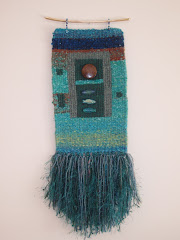
A component of the "Alphabet Project"
It's an interesting experience, to be a student again. I haven't stepped foot in a formal classroom (other than my own) in over thirteen years since I was studying for teacher certification at USM.
I am now a first semester student enrolled in the MFA program at Heartwood College of Art, balancing my studies with full-time teaching, community organizing, family, and business. The part-time low residency program is perfect for me in that I am able to continue my regular teaching job while doing the bulk of my studies in my own studio space. The twelve-hour-a-week studio commitment seemed peanuts compared to the usual pace I keep. However, I soon learned that in order to meet the deadlines I needed to devote much more than twelve hours a week.
Like my older high school students, when given the first assignment, I immediately grumbled. Whiny me, thinking, "why can't I just do what I want to do?" Eventually, I came around to a project idea that piqued my excitement. Would I have come up with this particular idea had I not been instructed to follow certain parameters? How literal do I need to be in the interpretation?
The Heartwood program is set-up as two "classes" per semester. This inaugural semester we were asked to write two project proposals. One proposal was for something called the "Alphabet Project" which involves studying and rendering an object twenty six times.
Let me repeat this number in case it didn't register. Twenty-six (26).
I wanted to study fine arts so that I could focus on one-of-a-kind unique sculptures that would draw my attention away from the production pottery I had been doing the past few years. Isn't this, sort of, production work?
Eventually, after hours of sketching, researching, and thinking, I found an object that I could create twenty-six times while making each one a smaller component of a greater whole.
I began the actual sculpting the third week of January. Again, like my students, I hit a few rough spots. I had an idea I liked, but I didn't foresee some of the technical problems that I would have. In my mind's eye, and on paper, It all looked smooth-sailing. I have been working with clay for over twenty years and what could be so difficult in sculpting this little object a few times over?
Boy was I wrong. I came up against challenges like never before. It all appeared so simple at first, and by this point, I sure was wishing I could change my project. "Ah teacher...can I throw this one out and start all over again? Please?"
Since I usually say no to my own students, this just wasn't an option for me. So, forward I progressed.
Yesterday was a critical moment in the creation of this series. I had spent many hours working my ideas out on paper and in my mind for this particular component. I was a bit anxious, not knowing if I could make it happen. It took a few hours and two solid attempts, but I got the prototype created and am pleased with the result. Finally, I feel like my mind can rest a bit and I can let my hands do the work.
This will, however, be just a short respite from the heavy cerebral stuff. My mind will be buzzing overtime soon enough as I begin to plan for the next phase of the project.
It is good for me to be a student again. It encourages me to think a bit deeper than normal about what I am sculpting, to analyze my process, and to articulate my ideas in a way that others will understand. I am gaining new empathy for my own students, and showing them that the process can be difficult for even a somewhat honed artist, but the rewards are great. My students are able to see the passion that drives me as an artist and a teacher, and it is that passion that in turn inspires my students.
I am learning lessons as I go. Some lessons are repeat lessons, lessons that I thought I had learned but never really fully embraced. Perhaps this is sort of like a distinction between "book knowledge" and "hands-on experience". And, sometimes, you just have to brush-up once in a while, lest you forget.
Lessons Learned:
1. Artists are given a problem to solve and if left to their own, will come up with a creative solution. It may not fit the literal interpretation of the "rules" exactly, but artists like to add their own spin to things...and more importantly, are expected to.
2. Things don't always go as planned. You can plan on it!
3. Perfectionism is a myth, and if you always strive for it, you will be discouraged many-a-time.
4. Process is equal to, or greater than, the final product. It's all about the journey.
I end this week's blog with a quote from the book Bird by Bird by Anne Lamott. Though primarily about the experience of being a writer, I felt that this analogy related quite well to the work of visual artists. It has helped me to put my sometimes harrowing first semester MFA project experience into perspective.
"Writing a novel is like driving a car at night, you can only see as far as your headlights, but you can make the whole trip that way."









.jpg)






.jpg)











2 comments:
My version of #2 is Expect the unexpected!! :)
cheers,
Nicky
You have a wise way of dealing with frustration, going deeper than your first reaction to see the difficulties and accomplishments of an artistic journey. It is a very meaningful journey you are on. And you are quite a writer, too!
OWL
Post a Comment